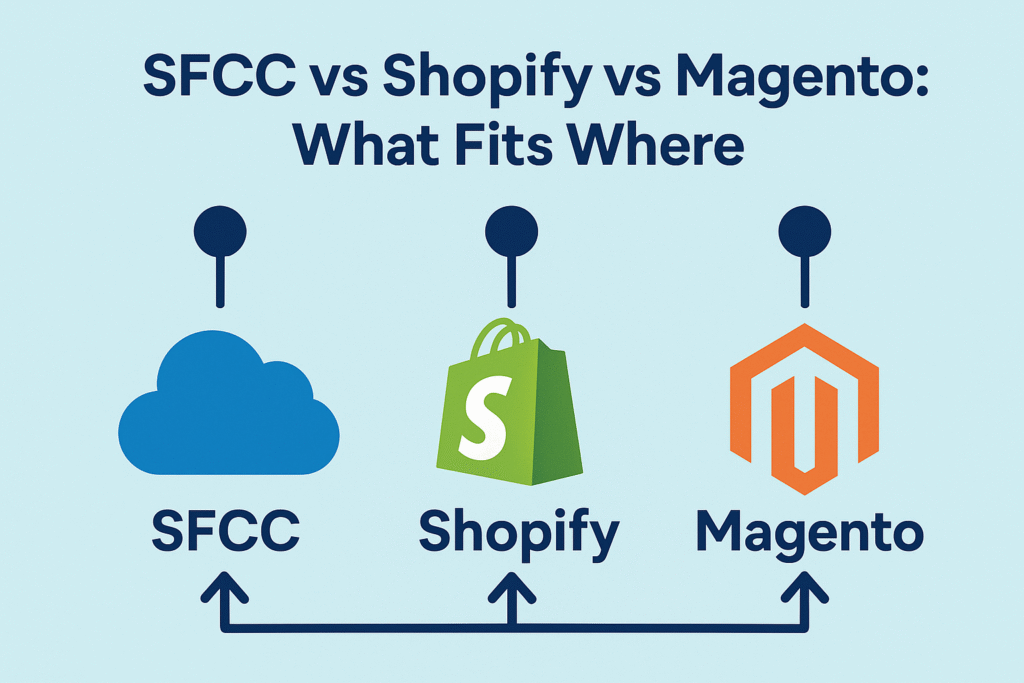In the rapidly evolving world of e-commerce, choosing the right platform can make or break your online business. Salesforce Commerce Cloud (SFCC), Shopify, and Magento each bring unique strengths-and trade-offs-to the table. This guide will help you decide which solution aligns best with your goals, whether you’re a bootstrapped startup or an enterprise-level retailer.
1. Platform Overviews
Salesforce Commerce Cloud (SFCC)
- Enterprise-Grade: Built for high-volume retailers handling complex catalogs and global roll-outs.
- Cloud-Native: Fully hosted on Salesforce’s infrastructure with automatic scaling, PCI compliance, and 24/7 support.
- Ecosystem Integration: Seamlessly connects to Salesforce CRM, Service Cloud, Marketing Cloud, and more.
Shopify
- Ease of Use: Intuitive UI, one-click theme installs, and a rich App Store make setup and management a breeze.
- SaaS Model: Fully hosted, with built-in payment processing via Shopify Payments.
- Scale Path: Ideal for SMBs; with Shopify Plus, it can handle mid-market volumes.
Magento (Adobe Commerce)
- Open Source & Flexible: Self-hosted (Community Edition) or cloud-hosted (Commerce Cloud) options.
- Custom Development: Deep control over every aspect, from checkout flow to database structure.
- Robust Marketplace: Thousands of extensions and themes for nearly any specialized need.
2. Key Comparison Criteria
| Criteria | SFCC | Shopify | Magento |
| Time to Market | 6–12 months (enterprise rollout) | Days–weeks (small shop) | Weeks–months (dev-intensive) |
| Upfront Cost | High (license + implementation) | Low (monthly tiers starting ~$39) | Medium–High (hosting + dev costs) |
| Ongoing Fees | Annual license + 1–3% of GMV | Monthly + transaction fees | Hosting + maintenance |
| Customization | Moderate (SFCC framework) | Limited to themes & apps | Unlimited (open codebase) |
| Scalability | Enterprise-grade | SMB → Mid-market (Plus) | High (with right infrastructure) |
| Integrations | Native Salesforce stack | Apps & APIs | APIs + custom modules |
| Support | 24/7 enterprise support | 24/7 (Plus) / community (basic) | Community + paid support plans |
3. Which Platform Fits Your Needs?
When to Choose SFCC
- Global Enterprises with multiple brands, currencies, and languages.
- Tight CRM/Marketing Integration demands (Salesforce ecosystem).
- High Traffic & Complex Catalogs requiring robust scaling and uptime SLAs.
When to Choose Shopify
- Lean Startups & SMBs seeking rapid launch and minimal technical overhead.
- User-Friendly Management-non-technical teams can handle day-to-day.
- App-Driven Features for common needs (email marketing, subscriptions, reviews).
When to Choose Magento
- Brands Requiring Deep Customization or unique checkout/user-experience flows.
- Developers & Agencies ready to maintain their own hosting, security, and updates.
- Mid-to-Large Retailers with technical resources and a need for extensibility.
4. The Digitup Advantage
No matter which platform you select, success hinges on experienced implementation and ongoing optimization. That’s where ecommerce development services from Digitup come in:
- Platform-Agnostic Expertise: Certified SFCC, Shopify, and Magento developers.
- End-to-End Support: From initial architecture and theme design to integrations, performance tuning, and long-term growth.
- Data-Driven Results: We leverage analytics, A/B testing, and continuous improvement to boost conversions.
Conclusion
Selecting between SFCC, Shopify, and Magento boils down to your business scale, technical resources, and growth ambitions:
- SFCC for sprawling enterprise demands.
- Shopify for speed, simplicity, and reliable SaaS.
- Magento for bespoke, developer-driven commerce.
Whichever path you choose, partnering with seasoned professionals is critical. Explore how Digitup ecommerce development services can accelerate your journey and maximize your ROI. Whether you’re launching your first store or overhauling a global platform, we’ve got you covered.


